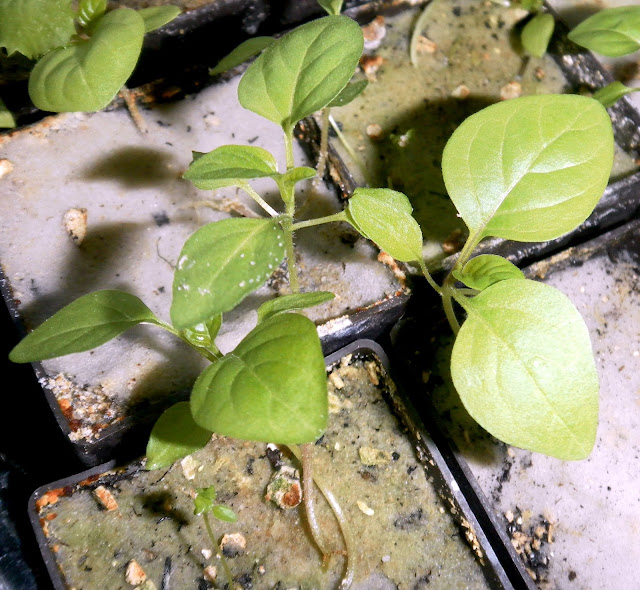
To
genus Physalis belongs very numerous, mostly American species.
The most known one is Cape Gooseberry (Physalis peruviana) –
it is tender perennial with edible fruits. Other well known species –
Chinese Latern (Ph. alkekengi) creates very ornamental but
inedible fruit, but it is fully frost hardy. Almost nobody knows that
there exists intermediate species – frost hardy and with edible
delicious fruits. They are very difficult to buying. I dreamed about
them by long time and after years of lokking for I have gotten the seeds
of two such species: Ph. heterophylla and Ph.
longifolia var. subglabrata. Both these
species are fully resistant to frost in my zone 6b. They starts to
abundant fruiting in 2-3 year of life. They germintes well if seeds
were soaked in GA3 solution (2000ppm by 24 hours) if sown surface.
The seeds can be also short or long cold stratified (after my
experience I can say that the seeds of Ph. longifolia var.
subglabrata can be kept in stratification by 1-1,5 year or even
longer if possible and germinated only when they are taken to warm
temperature). The seeds the best sow inside in pots in spring and
replant outside in May/June.
Bellow
there are descriptions of the species which I grew:
Physalis
longifolia var. subglabrata (smooth
groundcherry, wild tomatillo) –
it
is perennial (frost hardy to zone 5) to about 150
cm
(5 ft)
tall, with smooth leaves and delicuious edible fruits. Native to
eastern Canada, much of the continental United States and northern
Mexico. It survives in half-shade but the fruits better ripe in full
sun.
The seedlings
It blooms in first year but does not creates ripe fruits
Plants in second year of life
Flowers of this species are large
Ripe fruits (very delicious)
Physalis
heterophylla (Clammy Groundcherry, Rowell's groundcherry)
– it is frost hardy (to at
least zone 6) perennial to 50 cm (=2 ft) tall with hairy leaves and
delicious fruits. Native to North the eastern United States and
Canada. It likes half-shade or full sun and is much drough resistant.
The leaves of this species are very hairy
Plant in early summer
Flowers are very lovely
The ripe fruits in hairy calyxes
Bellow
there are a few photos of wild Chinese Latern (Physalis alkekengi)
from lower slopes of E'meishan Sichuan, altitude 1700m
(5666 ft). I was very suprised when I tasted its fruits and they has been edible, tasty and not bitter (as forms of this species cultivated commonly in Europe as ornamental wich have bitter fruits).
It haves star-like white flowers
The fruits of my wild plant are orange-red and delicious (not bitter! - as commonly cultivated forms) - they are already dried on the photo
There are numerous other hardy gourdcherries species yet. If you have available the seeds of any of them please write to me.























I'm in Pennsylvania, USA, and I've successfully gotten the local native longifolias to grow from seed. I'm having a harder time finding heterophyllas around here, but I did find some patches of them, and I've planted the seeds and will see if they sprout next summer. For some reason, all the patches of heterophylla were in terrible condition. They were being destroyed by bugs, and all the berries were rotten, moldy, weirdly deformed, like they all had some kind of disease or something. The longifolia is extremely common, very strong and healthy, and very prolific, in my location. Those are the only two species that I have found growing wild where I live, and I love them. Did you find anything weird about your heterophyllas, like problems with their health? The ones I found also had hardly any fruits at all, whereas the longifolias had *millions* of fruits.
ReplyDeleteoops, I forgot to click 'notify me' on my comment, and I'm not sure if I can go back in and tell it to do that
Delete